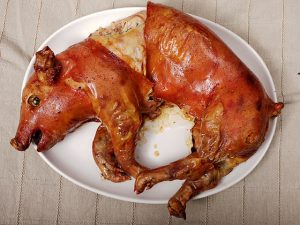Background – On 11 December 2013, 3 clustered cases of hepatitis E were reported on a coastal island in Brittany. Cases had consumed spit-roasted and stuffed piglet during a wedding meal. The raw stuffing was partly made from the piglet liver. Investigations were carried out to identify the source and vehicle of contamination, and evaluate the dispersion of the hepatitis E virus (HEV) in the environment.
 Methods – A questionnaire was administered to 98 wedding participants who were asked to give a blood sample. Cases were identified by RT-PCR and anti-HEV serological tests. A retrospective cohort study was conducted among 38 blood sampled participants after the exclusion of participants with evidence of past HEV immunity. Relative risks (RR) with their 95% confidence intervals were calculated based on foods consumed at the wedding meal using univariate and multivariable Poisson regressions.
Methods – A questionnaire was administered to 98 wedding participants who were asked to give a blood sample. Cases were identified by RT-PCR and anti-HEV serological tests. A retrospective cohort study was conducted among 38 blood sampled participants after the exclusion of participants with evidence of past HEV immunity. Relative risks (RR) with their 95% confidence intervals were calculated based on foods consumed at the wedding meal using univariate and multivariable Poisson regressions.
The human HEV strains were compared with the strains detected in the liquid manure sampled at the farm where the piglet was born and at the inlet of the island wastewater treatment plants.
Results – 17 cases, including 3 confirmed cases, were identified and 70.6% were asymptomatic. Acute HEV infection was independently associated with piglet stuffing consumption (RR=1.69 [1.04-2.73]). Human strains from the index cases, veterinary and environmental HEV strains were identical.
Discussion – The outbreak was attributable to the consumption of an undercooked pig liver-based stuffing. After infection, the cases have probably become a temporary reservoir for HEV, which was detected in the island’s untreated wastewater.
Hepatitis E outbreak associated with the consumption of a spit-roasted piglet, Brittany (France), 2013
Épidémie d’hépatite E associée à la consommation d’un porcelet grillé à la broche, Bretagne, 2013. Bull Epidémiol Hebd. 2016;(26-27):444-9
Y Guillois, F Abravanel, T Miura, N Pavio, V Vaillant, S Lhomme, et al.
http://invs.santepubliquefrance.fr/beh/2016/26-27/2016_26-27_3.html
 This means that ingesting raw pork liver could mean you’re ingesting a strain of HEV that’s similar enough to human HEV that it could cause you get infected.
This means that ingesting raw pork liver could mean you’re ingesting a strain of HEV that’s similar enough to human HEV that it could cause you get infected.
